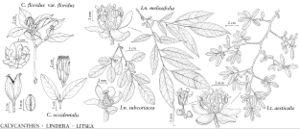Calycanthaceae
Shrubs, deciduous, rhizomatous, aromatic. Leaves opposite, without stipules, petiolate. Leaf blade: margins entire or, on fast-growing shoots, occasionally with a few teeth. Inflorescences terminal on short, leafy branches of current growth, solitary flowers. Flowers bisexual. Hypanthium urn-shaped; tepals and stamens perigynous; inner tepals, stamens, and staminodes with succulent, white food bodies at tips. Tepals 15-30, fleshy, petaloid, spirally inserted on outside of hypanthium. Stamens 5-30, spirally inserted at top of hypanthium; staminodes 10-25, on inner surface of hypanthium; locules opening by longitudinal slits. Pistils 5-35, 1-carpellate, spirally inserted within hypanthium; ovules 2 per locule, distal ovule abortive, submarginal; style elongate, filiform; stigma dry, decurrent. Fruits achenes, 1-35, dark reddish brown, cylindric, pubescent, enclosed within enlarged, fibrous persistent hypanthium (pseudocarp). Seeds: endosperm absent.
Distribution
Temperate North America and China.
Discussion
Genera 3, species 6 (1 genus, 2 species in the flora).
Calycanthus is often grown ornamentally. Also in cultivation is Chimonanthus praecox (Linnaeus) Link, an eastern Asiatic shrub. Chimonanthus differs from Calycanthus in its scaly buds and yellow flowers that appear long before the leaves.
Calycanthus contains calycanthine, an alkaloid similar to strychnine, and it is toxic to humans and livestock (W. H. Lewis and M. P. F. Elvin-Lewis 1977).
